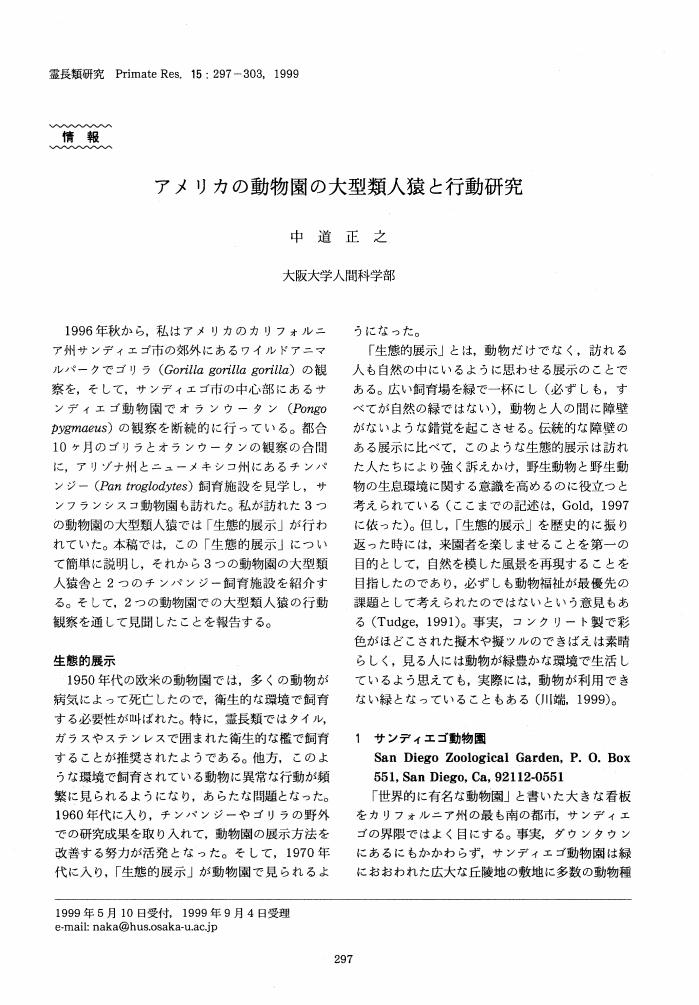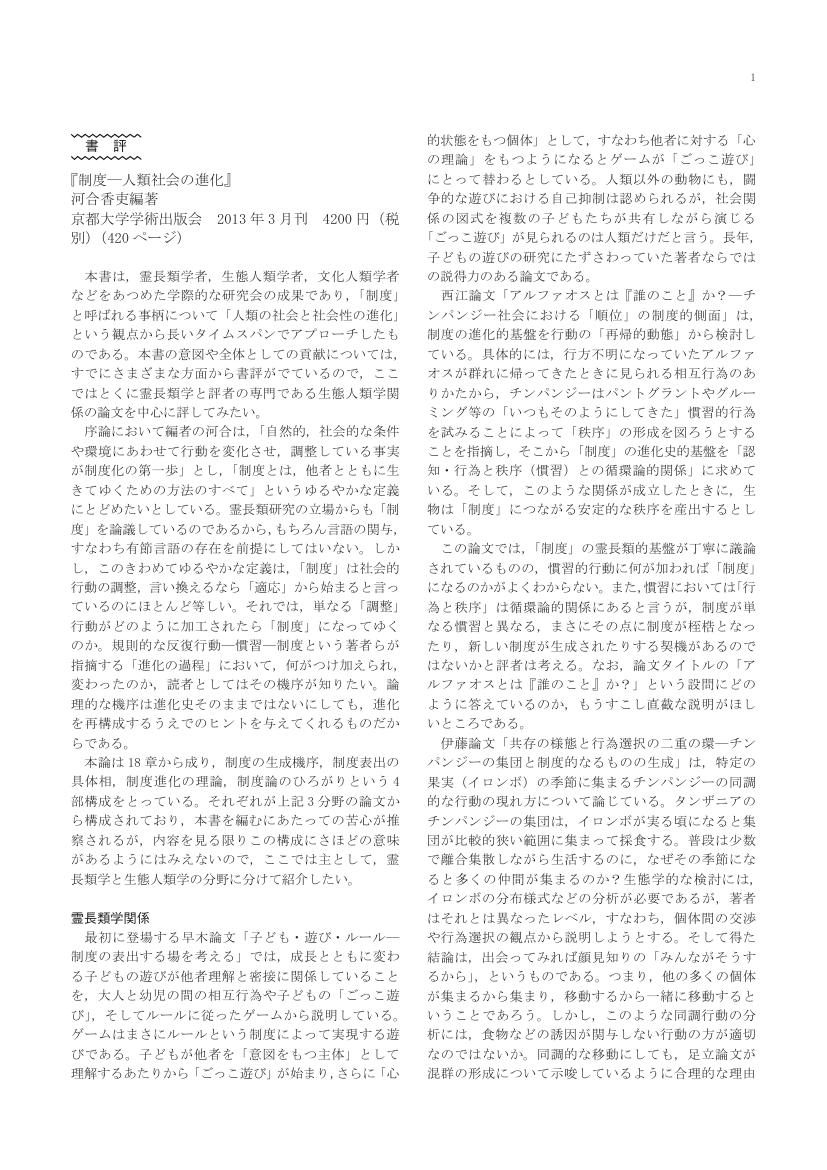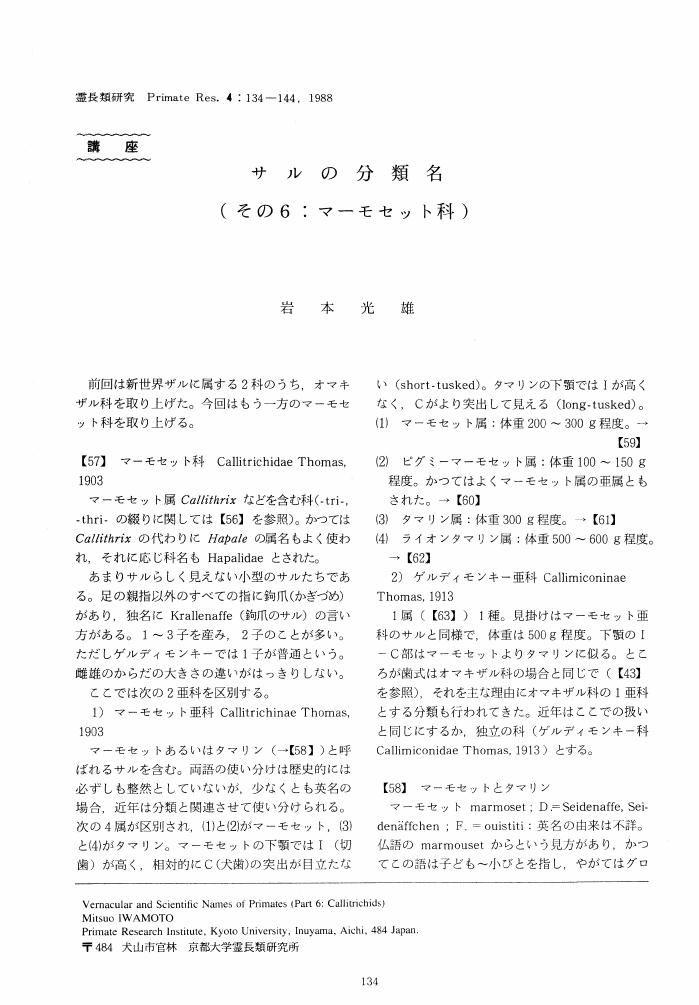1 0 0 0 OA 「社会的なるもの」とはなにか?:他者との関係づけにおける「決定不可能性」と「創造的対処」
- 著者
- 北村 光二
- 出版者
- 日本霊長類学会
- 雑誌
- 霊長類研究 (ISSN:09124047)
- 巻号頁・発行日
- vol.24, no.2, pp.109-120, 2008-12-20 (Released:2009-08-11)
- 参考文献数
- 11
- 被引用文献数
- 1 1
This paper aims to consider why the sphere of social phenomena is significant in the study of primates, including humans, and what aspects of the phenomena we should focus on in order to understand its significance. Although the process of making relations with others may easily become undecided, it may not be retained. We humans cope with such undecidability by paying attention to the motivation of activity easily shared by participants, or adequate readiness for regulating each other's interaction. This does not mean that the social sphere is independent of other spheres, but these characters are common to the activities of making relations with the natural environment for surviving. The social sphere should be placed in the larger range of phenomena produced by the activities of making relations with the outer world in general. An individual animal tries to decide his act of making relation with an object depending on the meaning of the object, while he tries to identify the meaning depending on his act of making relation with the object. Here, the undecidable circle is formed. The same situation is found in the case of making relations with others. That is to say, one tries to decide his act to the other depending on the other's act while the latter decides his act depending on the former's act, so that the undecidable circle is also formed here. The undecidability in the process of making relations with objects is usually perfectly hidden. However, the other's selection in the process of making relation with the object is always apparent in the social sphere. The other not only makes the undecidability apparent by making a different selection from my own, but also teaches a new way of coping with it by sharing the motivation with him or regulating the process of interaction with him.
1 0 0 0 OA アメリカの動物園の大型類人猿と行動研究
- 著者
- 中道 正之
- 出版者
- 日本霊長類学会
- 雑誌
- 霊長類研究 (ISSN:09124047)
- 巻号頁・発行日
- vol.15, no.2, pp.297-303, 1999 (Released:2009-09-07)
- 参考文献数
- 6
1 0 0 0 OA 音声研究から霊長類の心を探る
- 著者
- 小田 亮
- 出版者
- 日本霊長類学会
- 雑誌
- 霊長類研究 (ISSN:09124047)
- 巻号頁・発行日
- vol.13, no.1, pp.65-71, 1997 (Released:2009-09-07)
- 参考文献数
- 34
Most studies about mental abilities in nonhuman primates have been held in laboratory conditions. Considering the highy developed social organization of the primate species, however, it is necessary to study about their mental abilities in free-ranging conditions. Numerous studies have been made on natural vocal communication of nonhuman primates. Results of the studies tell mental abilities of nonhuman primates as well as functional significance of vocalizations in their lfe. This paper reviews some studies about nonhuman primate vocal communication and shows examples of mental abilities emerged in these studies, which is recognition of other individuals, perception of quantity, understanding of causal reasoning, categorization, and ability of deception.
1 0 0 0 OA ボノボのメスの集団間移籍と近親交配の回避
- 著者
- 橋本 千絵 古市 剛史
- 出版者
- 日本霊長類学会
- 雑誌
- 霊長類研究 (ISSN:09124047)
- 巻号頁・発行日
- vol.17, no.3, pp.259-269, 2001 (Released:2009-09-07)
- 参考文献数
- 33
- 被引用文献数
- 1 5
We examined the 20-years records of female transfer of wild bonobos at Wamba, D. R. Congo. Most females left their natal group between 6 and 9 years old, and immigrated into new groups between 10 and 12 years. Females seemed to travel several groups before settling in a new group. After settling down, they start reproduction and will not transfer to other groups for the rest of their life. We examined average of coefficient of consanguinity of males with whom females may copulate in new groups. The probability of inbreeding drastically decreases when a female transfers groups, and it decreases according to the amount of intergroup travel. Differences in female transfer pattern between bonobos and chimpanzees seem to be due to the differences in the risks of traveling alone, such as predators, social relationships between females, and high social status of females. The balance between cost and benefit of intergroup transfer may determine philopatric social structure in chimpanzees and bonobos.
1 0 0 0 絶滅種を含めた霊長類の系統推定
- 著者
- 伊藤 毅
- 出版者
- 日本霊長類学会
- 雑誌
- 霊長類研究 (ISSN:09124047)
- 巻号頁・発行日
- pp.17-26, 2016
Molecular phylogenetic analyses have established most components of primate systematic classiications, which are signiicantly diferent from the traditional morphology-based classiications. This becomes an issue when inferring the phylogeny of extinct taxa, for which molecular data are usually unavailable. Researchers have attempted to extract phylogenetic signals from morphological characters to infer relationships between extant and extinct taxa. One of the most disruptive factors obscuring phylogenetic signals of morphological characteristics is size-related shape variation (i.e., allometry). Although some issues remain, researchers have successfully detected phylogenetic information that was previously hidden by the strong efects of allometry. Recently, the importance of morphological data and fossil evidence has been reconsidered, and the total-evidence approach has been resurrected. This approach incorporates both extinct and extant taxa and uses all available data, i.e., both molecular and morphological characters. The validity of the total-evidence approach should be evaluated under various conditions using simulation studies and tested using the actual data for various primate taxa.
- 著者
- 市川 光雄
- 出版者
- 日本霊長類学会
- 雑誌
- 霊長類研究 (ISSN:09124047)
- 巻号頁・発行日
- pp.32.011, (Released:2016-06-19)
1 0 0 0 OA 霊長類とシラミの関係
- 著者
- 座馬 耕一郎
- 出版者
- 日本霊長類学会
- 雑誌
- 霊長類研究 (ISSN:09124047)
- 巻号頁・発行日
- pp.29.017, (Released:2013-12-13)
- 参考文献数
- 107
- 被引用文献数
- 2 2
The relationship between primates and lice is discussed. Lice are ectoparasites that live on the body surface of mammals and, in contrast to ticks and fleas, do not leave the host during their life cycle. Host mammals may experience adverse effects from lice, such as anemia and skin irritation. Moreover, lice are vectors of infectious diseases; for example, human lice (Pediculus humanus) transmit the epidemic typhus pathogen between humans (Homo sapiens). DDT virtually eliminated human lice in several countries after World War II. Early Japanese primatologists who began research during this period had little interest in the relationship between primates and lice. Primates groom each other to remove lice, ticks, and small objects. Prosimians use their lower incisors to groom, similar to rodents and African antelopes, whereas anthropoids, which have a retinal fovea with high visual acuity and functional fingers that allow them to find and pick small ectoparasites from the body surface, groom using their hands and mouth. Japanese monkeys (Macaca fuscata) and lice (Pedicinus obtusus, P. eurygaster) have an entwined host-parasite and predator-prey relationship. Lice lay nits on monkeys, who are hosts, in areas where hair growth is dense because the hair conceals nits from the monkeys, who are their predators. Monkeys remove and eat nits according to nit density. Given the high intrinsic rate of natural increase in lice, monkeys need to groom daily. This necessity may explain why monkeys live with grooming partners making social groups. The development of simplified techniques to estimate louse infection in primates will advance the study of socioecological models and lice infection dynamics in primate metapopulations.
- 著者
- 佐倉 統
- 出版者
- Primate Society of Japan
- 雑誌
- 霊長類研究 (ISSN:09124047)
- 巻号頁・発行日
- vol.29, no.1, 2013
1 0 0 0 OA チンパンジーにおける砂の対象操作の実験的分析
- 著者
- 武田 庄平 筒井 紀久子 松沢 哲郎
- 出版者
- 日本霊長類学会
- 雑誌
- 霊長類研究 (ISSN:09124047)
- 巻号頁・発行日
- vol.15, no.2, pp.207-214, 1999 (Released:2009-09-07)
- 参考文献数
- 13
Sand manipulations in four captive female chimpanzees (Pan troglodytes) were experimentally analysed. Every experimental session was done at the individual situation. Each individual was observed in the experimental booth under four 30min. conditions; with an experimenter and no object, with an experimenter and 16 objects, with an experimenter and 7 objects, and with no experimenter and 7 objects. In every conditions, 10kg. sand was mounted at the centre of floor in the booth. Comparing the amount of time of sand manipulations under each conditions, the conditions with an experimenter and objects facilitated chimpanzees to manipulate sand, although the small number of objects was more efficient. For the ultimate purpose of abstracting the intelligence of chimpanzee, we made the ethogram of sand manipulation. Each bout of sand manipulation observed was categorized into four contexts; relating with their own body and object, relating with only their own body, relating with only object, and specific manipulation. The cases of sand manipulation initiated with “scoop”, “drop”, “grasp”, “scrape”, and “touch” were the most popular for all contexts. Chimpanzees could spontaneously construct the triad relationship of sand (with objects), experimenter, and themselves. Apparent “pretend play” could not be observed in the present study, but some of nearly “pretend play” were observed. These observational evidences allowed us to speculate that chimpanzees can symbolically manipulate sand.
1 0 0 0 OA 巻頭言
- 著者
- 山極 壽一
- 出版者
- 日本霊長類学会
- 雑誌
- 霊長類研究 (ISSN:09124047)
- 巻号頁・発行日
- vol.23, no.1, pp.1-2, 2007 (Released:2009-01-01)
1 0 0 0 OA 嵐山・幸島におけるニホンザルの死産の報告
- 著者
- 勝 野吏子 鈴村 崇文 山田 一憲 中道 正之
- 出版者
- 日本霊長類学会
- 雑誌
- 霊長類研究 (ISSN:09124047)
- 巻号頁・発行日
- vol.30, no.1, pp.163-172, 2014 (Released:2014-08-02)
- 参考文献数
- 21
- 被引用文献数
- 4
Here, we have reported two cases of diurnal stillbirths in free-ranging groups of Japanese macaques (Macaca fuscata), Arashiyama and Koshima groups. One infant was born prematurely and in breech position, while the other seemed to be a full-term infant born in front position. The two mothers had little interaction with other members of the group throughout parturition. The group members, except for juveniles, also showed little interest in the mothers. The mother of the infant born in the breech position licked the body of the infant, as in the case of live births. Moreover, both mothers carried the infants ventrally. However, the two mothers also showed behaviors that were different from those usually observed after a live birth. The mother of the infant born in breech position tore parts of the infant's skin and ate them. The other mother dragged the infant by grabbing the umbilical cord. Previous studies have reported that mothers carry infants that died after birth, but it was unclear whether interactions with live infants were required for such maternal behavior. Our observations suggest that some maternal behaviors can be observed even when the infants die before parturition. At the same time, the cases reported by us show the possibility that infants born dead may influence the expression of certain unusual behaviors.
1 0 0 0 OA マレーシア・サバ州のテングザルの調査と保護
- 著者
- 村井 勅裕
- 出版者
- 日本霊長類学会
- 雑誌
- 霊長類研究 (ISSN:09124047)
- 巻号頁・発行日
- vol.20, no.2, pp.129-132, 2004 (Released:2005-05-31)
- 参考文献数
- 16
1 0 0 0 OA サルの分類名(その3:コロブスモンキー,ラングールなど)
- 著者
- 岩本 光雄
- 出版者
- 日本霊長類学会
- 雑誌
- 霊長類研究 (ISSN:09124047)
- 巻号頁・発行日
- vol.3, no.1, pp.59-67, 1987 (Released:2009-09-07)
1 0 0 0 OA 三和化学研究所におけるチンパンジー妊娠100例の総括
- 著者
- 鵜殿 俊史 寺本 研 早坂 郁夫
- 出版者
- 日本霊長類学会
- 雑誌
- 霊長類研究 (ISSN:09124047)
- 巻号頁・発行日
- vol.15, no.2, pp.243-250, 1999 (Released:2009-09-07)
- 参考文献数
- 15
- 被引用文献数
- 4 6 2
The Kumamoto Primates Park, Sanwa Kagaku Kenkyusho CO., Ltd. had successfully bred chimpanzee from 1982 to 1999. The breeding statistics of 100 pregnancies, observed for the 17 years, were reviewed. The breeding females were 24 wild born and 3 captive born. Neonatal diagnoses were performed on the next day of the birth. Of 100 pregnancies, diagnosed by urinary CG test and/or ultrasonography, 11 resulted in abortions, 5 in stillbirths, and 85 in live births (containing a monozygotic twins). The mean birth weight and gestational period of 84 live born infants was 1793g (n=74, 930-2400) and 229.4 days (n=84, 181-250). Seven of 11 abortions occurred in early stage of pregnancies (45-65 days). Infant mortality in the first year of life was 10.7%: 6 died from 7 to 16 days of age, 3 died after 50 days of age. Three of dead 6 neonates were low birth weight (under 1500g). There was no infant died under 7 days of age or over 1 year of age. Perinatal mortality was calculated at 0.12. 73.2% of deliveries occurred in the nighttime (n=82). Placentaphagia were observed in 65.7% cases of 73 parturitions. The seasonal difference was significant on frequency of conceptions (χ2=10.16, p<0.02), but not significant on frequency of births (χ2=7.62, p>0.05). Twenty-nine infants were nursery-reared primarily due to inadequate maternal care (48%) or low birthweight (28%). Only one infant died under nursery-reared condition. These data provide useful information to sustain captive chimpanzee populations.
1 0 0 0 OA サルの分類名(その6:マーモセット科)
1 0 0 0 OA サルの分類名(その8:原猿)
- 著者
- 松本 晶子
- 出版者
- Primate Society of Japan
- 雑誌
- 霊長類研究 (ISSN:09124047)
- 巻号頁・発行日
- vol.20, no.2, pp.165-166, 2004
1 0 0 0 OA ニホンザルにおける稀にしか見られない行動に関するアンケート調査結果報告
- 著者
- 中川 尚史 中道 正之 山田 一憲
- 出版者
- 日本霊長類学会
- 雑誌
- 霊長類研究 (ISSN:09124047)
- 巻号頁・発行日
- pp.1111280025, (Released:2011-11-30)
- 参考文献数
- 29
- 被引用文献数
- 4 7
Questionnaire on infrequently-observed behaviors (IOBs) in Japanese macaques (Macaca fuscata) were given to primatologists. This survey aimed to provide basic information on the degree of rarity of each behavior. The questionnaire consisted of questions for respondents themselves, (e.g., name, research carrier, daily observation time), focal group (name of group and local population, captive, provisioned free-ranging, crop-raiding or purely wild), and IOBs. Experience of direct observation of 36 candidates of IOBs was also requested to answer by yes, no, or impossible to answer because of ambiguous memory or unawareness of its behavior. In total, 39 answer sheets were obtained from 32 respondents. The top 10 IOBs and the number of those answering "yes" in parenthesis are as follows: mating interruption by juveniles (1), simultaneously nursing different-aged offspring (1), tool-use (1), single mount ejaculation (2), transporting the older offspring (2), nursing the older offspring (2), simultaneously transporting different-aged offspring (3), pulling the hair of female chin as a courtship behavior by male (4), twin birth (4), and (diurnal) birth (6). Some of IOBs, such as mating interruption by juveniles, seem to be due to ambiguous memory or unawareness of its behavior. Apparent inter-population differences in the percentage of respondents answering "yes" to the all the respondents giving definite answers were found in some behaviors, such as embrace-rocking behaviors, mating behaviors in birth season, stone-handling, and feeding on vertebrates. Some of them, like the latter two, seem to have something to do with provisioning. With the modification of three categories by Nakamichi et al. (2009), we proposed the following five categories of IOBs: I) behaviors which are difficult to be observed despite its common occurrence; II) behaviors which rarely occur in every population: III) behaviors which rarely occur in some populations, but frequently occur in the others; IV) behaviors which are difficult to identify and memorize despite its common occurrence; V) behaviors which rarely occur during the most of the time but temporally occur.
1 0 0 0 OA 房総半島に定着したアカゲザル集団におけるニホンザルとの交雑進行
- 著者
- 川本 芳 川本 咲江 川合 静 白井 啓 吉田 淳久 萩原 光 白鳥 大祐 直井 洋司
- 出版者
- 一般社団法人 日本霊長類学会
- 雑誌
- 霊長類研究 (ISSN:09124047)
- 巻号頁・発行日
- vol.23, no.2, pp.81-89, 2007-12-20 (Released:2009-03-13)
- 参考文献数
- 13
- 被引用文献数
- 6 7
We examined a total of 20 blood samples for assessment of the degree of hybridization between introduced rhesus macaques and native Japanese macaques in the Bousou Peninsula. Each individual was characterized by different kinds of genetic markers (two protein loci, mtDNA and one Y chromosome DNA) in order to evaluate paternal and maternal origin and the degree of hybridization. The sample individuals contained one adult male Japanese macaque, and all others were rhesus or rhesus hybrid born in the study population. Of these 19 natal, at least 15 (78.9 per cent) were hybrids. The estimated frequencies of Japanese macaque genes were 0.342 and 0.857 for autosomal and Y chromosomal genes, respectively. This result revealed a high degree of hybridization in the introduced rhesus population. A test for random mating suggested that the two species were intermixing without reproductive defects. As the habitat of native Japanese macaque troops on the peninsula are very close, removal of the hybrid population is urgently required to prevent the transfer of their genes into the Japanese macaque population. It is also important to begin monitoring for further potential gene flow between rhesus and Japanese macaques in the peninsula.
1 0 0 0 OA ニホンザルのビジランスを規定する社会的要因
- 著者
- 山本 真也
- 出版者
- 日本霊長類学会
- 雑誌
- 霊長類研究 (ISSN:09124047)
- 巻号頁・発行日
- vol.21, no.1, pp.19-26, 2005 (Released:2005-08-30)
- 参考文献数
- 25
- 被引用文献数
- 2 3
The present study investigated vigilance in Japanese macaques (Macaca fuscata) in reference to some social factors. Previous studies have suggested that social factors among conspecifics should be important for vigilance in primates. This study explored the relationship between individual's social rank and vigilance in estrous and non-estrous periods in female Japanese macaques. With a video camera, I recorded vigilance of 23 females among approximately 170 individuals of Arashiyama E-troop. The results were as follows. High degree of vigilance was observed in three conditions, 1)females in estrous period regardless of the rank, 2)low-ranking females in nonestrous period, and 3)females in estrous period consorting with low-ranking males. These results indicate that social relationship is an important factor which affects the degree of vigilance in female Japanese macaques.




